#whitey's lindy hoppers
Video
Black Americans are Soul People.
The amount of times I just watched this compilation made by BlackPowerBA. I love us. We are vibrant people with a culture unlike any other.
And that double dutch transition into Whitey’s Lindy Hoppers is the chef’s kiss.
#black history month#black american culture#whitey's lindy hoppers#james brown#I refuse to let anybody even think they can ethnocide or erase us
1K notes
·
View notes
Text
Parties
What makes a party? Amy Sedaris once wrote:
“When you see the word "party"...don't think of pony kegs and loud Southern rock or cigarillos and business women. Don't think of pools and diving for loose change. Don't think about cockfights - even though it's hard not to. Don't think tiki lights and fruity cocktails served in coconut shells on the patio, or a large group of drunken seamen clustered together shouting over each other. Think simplicity."
Parties are as old as homo sapiens themselves. But for most people, the thing that makes a party a party and not just a meeting with snacks is usually the music; preferably upbeat, and preferably loud.
Buddy Bolden was somebody who knew about loud music and parties. It was said that when he played in New Orleans you could hear him from across the river. And his song Funky Butt was, as Danny Barker once put it, "a reference to the olfactory effect of an auditorium packed full of sweaty people "dancing close together and belly rubbing." That's definitely one way to party.

The Bolden band around 1905 (top: Jimmy Johnson, bass; Bolden, cornet; Willy Cornish, valve trombone; Willy Warner, clarinet; bottom: Brock Mumford, guitar; Frank Lewis, clarinet)
Even though he's considered the King of Jazz, there are no known recordings of Buddy Bolden, who improvised his music and never wrote it down. Really the only thing we have to go by is Jelly Roll Morton's rendition, which came to be known as Buddy Bolden Blues or I Thought I Heard Buddy Bolden Say.
undefined
youtube
Jelly Roll Morton wasn't a man who shied away from a party. He made a name for himself playing ragtime in the brothels of New Orleans, and ragtime was, of course, known as the Devil's music. His rendition of Buddy Bolden Blues was considered so rude at the time that it was offensive even just to whistle it on the streets. Ruder still when you find out what Jelly Roll means. Or olfactory.
Some parties are planned and some are spontaneous. The difference between an average day at work and a spontaneous party could be as simple as the the presence of some unattended bongos, like in this scene from Hellzapoppin' - a weird film from 1941 with one of the most iconic dance scenes ever created.
undefined
youtube
That was Frances "Mickey" Jones, WiIliam Downes, Norma Miller, Billy Ricker, Willamae Ricker, Al Minns, Ann Johnson and Frankie Manning, also known as Whiteys Lindy Hoppers - all dancing to music by the Slim Slam band.
When a dance floor is involved, parties become divisive: you're either on the dance floor or you're not. The dance floor is where life plays out, where you define yourself, where acquaintances become something more. In an American high school scenario, the dance floor is a status symbol. Being on the dance floor with the right person is everything.
undefined
youtube
Good parties share a collective, unspoken energy. Maybe all parties serve some sort of need to rebel against something oppressive, something that you need to escape. At the very least parties are a chance to act out in a way you otherwise can't.
One epic film party scene worth mentioning is from Olivier Assayas' Cold Water, if only because the scene goes on for about thirty minutes. The director admits that at some point he felt he was witnessing an experience that was "possibly stronger than whatever [ended] up on the screen." It's a brilliant demonstration of that unspoken, rebellious energy that escalates into something unforgettable, something an onlooker would describe as a party even if party feels like too shallow of a word to describe it for those who are part of it.
undefined
vimeo
It should also be said that parties can be shallow, and not everyone likes a party. Some people see them as just another feature of the hedonic treadmill. Tim Holmes of Rolling Stones wrote about this next song in 1985, saying, "In "Swinging Party," life is a lilting series of ultimately empty, but nonetheless compulsory, soirees."
What inspires you to party?
#amysedaris music film cinema hellzapoppin coldwater parties thereplacements swingingparty soiree sixteencandles dance#Spotify
22 notes
·
View notes
Text
Whitey's Lindy Hoppers w/ Dancers' Names - Harlem Congaroos" on YouTube
youtube
One of the coolest dance numbers I've seen in a movie.
1 note
·
View note
Video
youtube
The Savoy Ballroom, occupying a whole block from 140th to 141st Streets on Lenox Avenue, may or may not have been the origin of the Lindy Hop (or Jitterbug), but its patrons were so energetic and creative in their dancing that it became known as the capital of Lindy Hopping. The fame of these young dancers travelled beyond Harlem, and the ballroom eventually formed its own group, Whitey’s Lindy Hoppers (named for its organizer, security guard Herbert White). Most of the dancers were Harlem teenagers who were thrilled to be able to earn money for doing what they loved.
The group became so famous that they were asked to appear in the Marx Brothers’ movie A Day at the Races in 1936. Five years later they were featured in the film Hellzapoppin’. This is an excerpt.
#New York#NYC#vintage New York#Harlem#vintage Harlem#Lindy Hop#Jitterbug#Whitey's Lindy Hoppers#Savoy Ballroom#Hellzapoppin#Herbert White#1930s#1940s#popular dancing
74 notes
·
View notes
Text
youtube
Hellzapoppin' was a nonsensical stage show that was turned into a movie. It is impossible to describe or to sum up, except to say that Olsen & Johnson took the time to feature the best and most athletic goddamn dancing on the planet. This video has added the names of the dancers, which are:
The Harlem Congaroo Dancers (a.k.a. Whitey's Lindy Hoppers): William Downes/Overalls & Frances "Mickey" Jones (0:39). Billy Ricker/Chef's Hat & Norma Miller (1:09). Al Minns/White Coat-Black Pants & Willa Mae Ricker (1:29). Frankie Manning/Overalls & Ann Johnson (1:55).
5 notes
·
View notes
Video
youtube
Thanks to @intergalacticgazette for requesting lindy hop!
Performed by: Whitey’s Lindy Hoppers (Wilda Crawford, Joe Daniels, Joyce Daniels, William Downes, George Grenidge, Frances “Mickey” Jones, Thomas “Tops” Lee, Frankie Manning, Lucille Middleton, and Norma Miller)
Number: “The Big Apple”
Choreographer: Frankie Manning
Style: Lindy Hop
From: Keep Punching (1939)
#dance#lindy hop#frankie manning#choreography#norma miller#whitey's lindy hoppers#wilda crawford#joyce daniels#joe daniels#william downes#george grenidge#frances jones#mickey jones#thomas lee#tops lee#lucille middleton#the big apple#vintage#dancing#dancers#retro#swing#swing dancing#swing dancers#1939#1930s#swing dance#keep punching
25 notes
·
View notes
Video
youtube
The Lindy Hop at its most stunning and athletic.
Slim & Slam* set the pace for Frankie Manning & Whitey’s Lindy Hoppers** in Hellzapoppin’ (1941).
*”To Slim Gaillard the whole world was just one big orooni.” —Jack Kerouac, On the Road
**The YouTube post says the dance troupe is the Manning-led Harlem Congeroos, which wasn’t formed until after WWII. The YouTube post is wrong.
#hellzapoppin#slim and slam#slim gaillard#slam stewart#frankie manning#whitey's lindy hoppers#lindy hop#dance#holy shit
2 notes
·
View notes
Video
youtube
The Big Apple Routine from the Movie Keep Punching performed by the Whitey's Lindy Hoppers
#The Big Apple Routine#Keep Punching#Whitey's Lindy Hoppers#Lindy Hop#The Big Apple#Movie#film#dance#ballo#dancing#lindy hoppers
8 notes
·
View notes
Photo

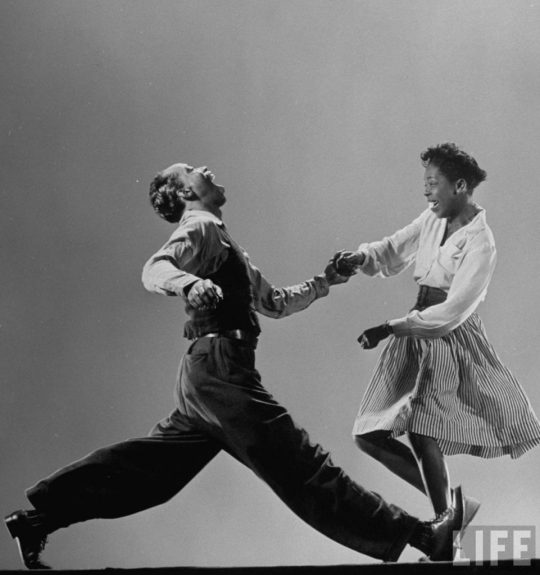
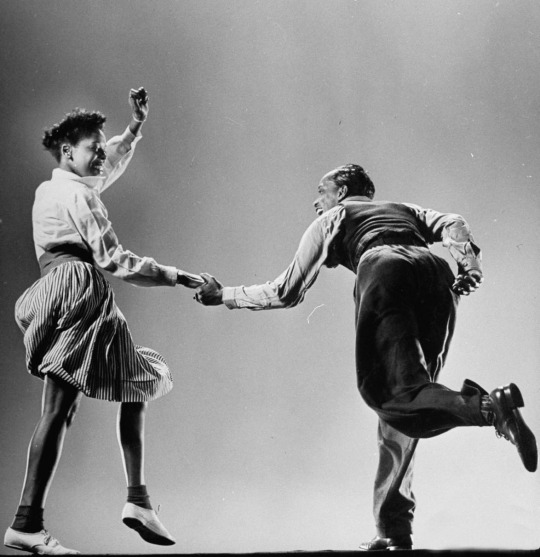
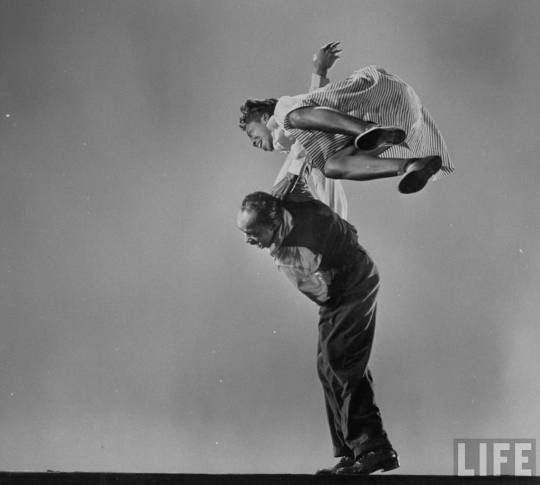

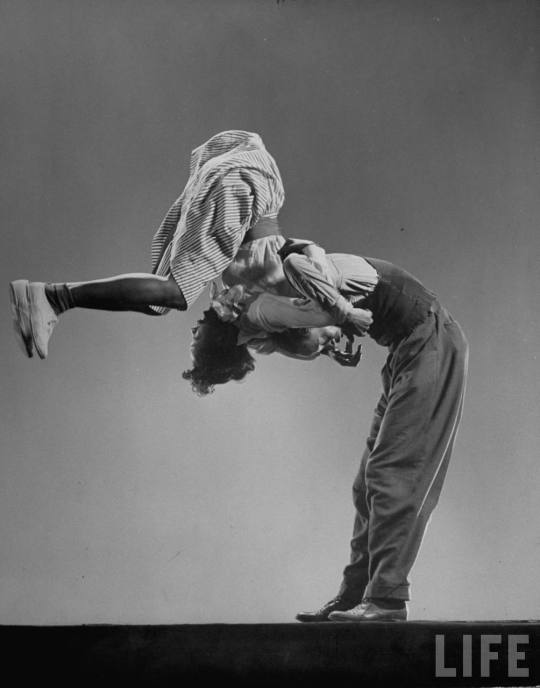
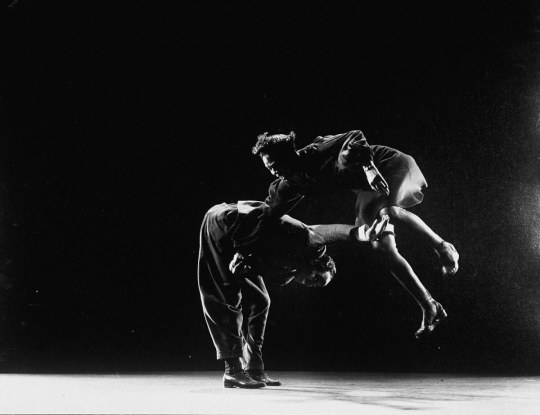



Willa Mae Ricker & Leon James (1943)
Imagine if swing dance made a big comeback 💃🏽
#willa mae ricker#leon james#whitey's lindy hoppers#swing dance#lindy hop#black american culture#life magazine#1940s
218 notes
·
View notes
Photo

1 note
·
View note
Video
youtube
Whitey's Lindy Hoppers from the 1941 film Helzapoppin.
This might just be the most amazing dance sequence you’ll ever see!
2 notes
·
View notes
Photo
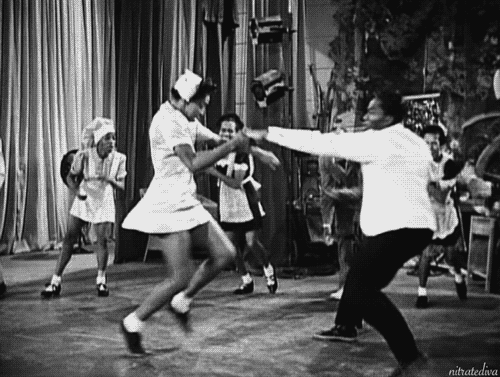
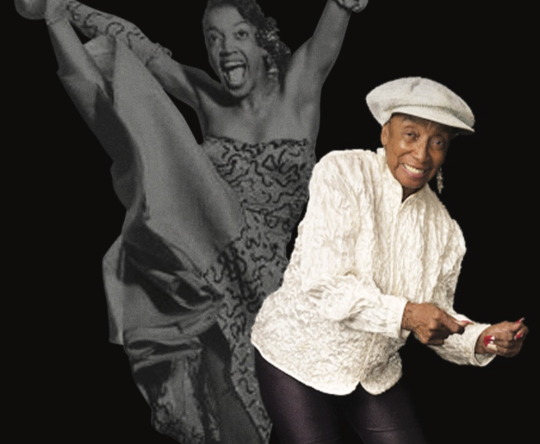

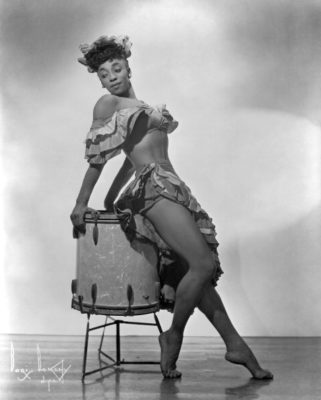

Dancer, Norma Miller BornDay...
*Norma Miller was born on this date, December 2, in 1919. She was an African American lindy hop dancer, choreographer, actress, author, and comedian known as the "Queen of Swing".
Norma Miller was born in Harlem, New York into mother Alma and father Norman, a soldier, both from Bridgetown, Barbados. She was named after her father, who died from pneumonia a month before her birth. She had an older sister, Dot. Young Miller took dance lessons from a young age. During the Great Depression, Miller and her family moved to an apartment near the Savoy Ballroom.
On Easter Sunday in 1932, when Miller was 12 years old, she was dancing outside the Savoy Ballroom, too young to enter. She was approached by George “Twist Mouth” Ganaway, "the greatest dancer at the Savoy," who was impressed with her dancing. Twist Mouth asked Miller to immediately be his partner in a competition occurring in the ballroom, which they won, before Miller was escorted back outside. Later that year, Miller entered the Savoy Lindy Hop Contest, held at the Apollo Theater. Miller entered with one of her high school friends, Sonny Ashby, and they won the contest. The performance prompted Herbert "Whitey" White, the dance master at the Savoy, to ask Miller to join his group, Whitey's Lindy Hoppers.
She was hired in 1934 at age 15, the youngest member of the group. In 1935, the troupe won the Harvest Moon Ball contest and then went on a 7-month European tour that began in the U.S. with headliner Ethel Waters. In California, the group appeared in the 1936 movie A Day at the Races. After the tour, Miller was hospitalized for fatigue. Miller rejoined the group in 1938. For a second time, the group performed at the Harvest Moon Ball, hosted by Ed Sullivan. Miller and her partner placed in the top 3, and Sullivan invited them to perform on Toast of the Town (later called The Ed Sullivan Show).
They appeared in the 1941 movie Hellzapoppin', where Miller played a dancing cook. When they returned from filming, the group went to Rio de Janeiro to perform for 10 months because of the start of World War II. She left Whitey's Lindy Hoppers in 1942 to produce and attend dance school. She took classes based in the techniques of Martha Graham, Hanya Holm, Doris Humphrey and Charles Weidman. She toured Canada and the United States and lived in Los Angeles before returning to New York in 1946. From 1952 to 1968, Miller directed and toured with the Norma Miller Dancers and Norma Miller and Her Jazzmen, both of which included Frankie Manning's son Chazz Young as well as her long-time partner Billy Ricker. In 1954, her group toured nationally with the Count Basie show. She and Cab Calloway introduced their comedy skit of Romeo and Juliet while performing in Miami Beach, where she lived until 1959. In 1972, Miller traveled to Vietnam on a solo comedy tour.
She moved to Las Vegas in 1977, where she starred in and produced shows. She returned to New York In 1982, where she lived and worked until 1990 when she returned to Las Vegas. Miller, who never married and left no immediate survivors, had a long-term relationship with her fellow “Hellzapoppin” performer Roy Glenn, who died in 1971. She appeared in at least nine other documentaries on dance, black comedy and other subjects, including a PBS series “Jazz” (2000). She was the subject of a children’s book by Alan Govenar, “Stompin’ at the Savoy: The Story of Norma Miller” (2006). Her own books include “Swing Baby Swing” (2010, with Darlene Gist), a chronicle of swing dancing over her century.
In 2018, Miller appeared at the Herrang Dance Camp in Sweden, an annual gathering since the 1980s of Lindy Hop lovers from around the world. Norma Miller died on May 5, 2019 at her home in Fort Myers, Fla. She was 99.
To Become a Dancer
See also:
- Seven Things You Should Know about Hellzapoppin'
- Harlem’s Norma “Queen Of Swing” Miller, 1919 – (Video)
- What Is the Lindy Hop
839 notes
·
View notes
Video
youtube
HELLZAPOPPIN! (In Living Color)
[colorized with DeOldify]
Hellzapoppin' is a 1941 film adaptation of the musical by the same name that ran on Broadway from 1938 to 1941. The film has a 5-minute long jazz and lindy hop dance sequence at approximately the 48th minute of the film performed by The Congaroo Dancers, played by Whitey's Lindy Hoppers, including Frankie Manning and Norma Miller. Slim and Slam are also part of the act. Manning choreographed the routine.
395 notes
·
View notes
Photo
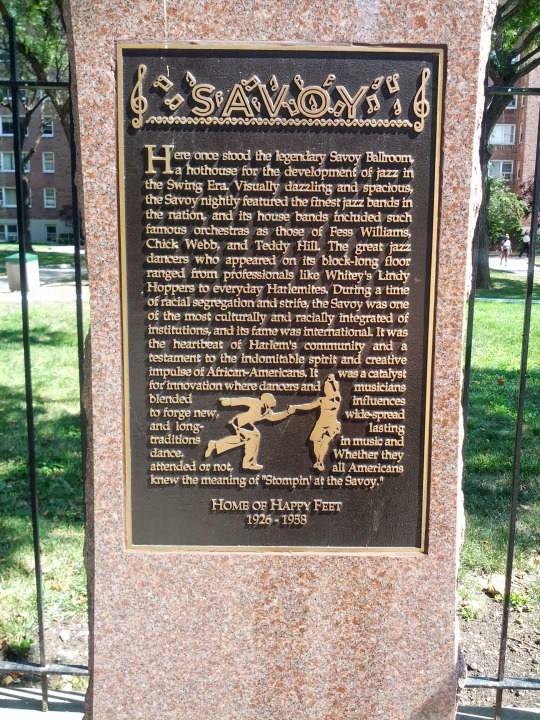

The Savoy Ballroom was a large ballroom for music and public dancing located at 596 Lenox Avenue, between 140th and 141st Streets in the Harlem neighborhood of Manhattan, New York City. Lenox Avenue was the main thoroughfare through upper Harlem. Poet Langston Hughes calls it the Heartbeat of Harlem in Juke Box Love Song, and he set his work "Lenox Avenue: Midnight" on the legendary street. The Savoy was one of many Harlem hot spots along Lenox, but it was the one to be called the "World's Finest Ballroom". It was in operation from March 12, 1926, to July 10, 1958, and as Barbara Englebrecht writes in her article "Swinging at the Savoy", it was "a building, a geographic place, a ballroom, and the 'soul' of a neighborhood". It was opened and owned by white entrepreneur Jay Faggen and Jewish businessman Moe Gale. It was managed by African-American business man and civic leader Charles Buchanan. Buchanan, who was born in the British West Indies, sought to run a "luxury ballroom to accommodate the many thousands who wished to dance in an atmosphere of tasteful refinement, rather than in the small stuffy halls and the foul smelling, smoke laden cellar nightclubs ..."
The Savoy was modeled after Faggen's downtown venue, Roseland Ballroom. The Roseland was a mostly white swing dance club. With swing's rise to popularity and Harlem becoming a connected black community, The Savoy gave the rising talented and passionate black dancers an equally beautiful venue. The ballroom, which was 10,000 square feet in size, was on the second floor and a block long. It could hold up to 4,000 people. The interior was painted pink and the walls were mirrored. Colored lights danced on the sprung layered wood floor. In 1926, the Savoy contained a spacious lobby framing a huge, cut glass chandelier and marble staircase. Leon James is quoted in Jazz Dance as saying, "My first impression was that I had stepped into another world. I had been to other ballrooms, but this was different – much bigger, more glamour, real class ..."
The Savoy Ballroom was named after the Savoy Hotel in London as those who named the ballroom felt this gave the ballroom a classy, upscale feeling, as the hotel is a very elite, upscale hotel.
The Savoy was popular from the start. A headline from the New York Age March 20, 1926, reads "Savoy Turns 2,000 Away On Opening Night – Crowds Pack Ball Room All Week". The ballroom remained lit every night of the week.
The Savoy had the constant presence of the best Lindy Hoppers, known as "Savoy Lindy Hoppers". Occasionally, groups of dancers such Whitey's Lindy Hoppers turned professional and performed in Broadway and Hollywood productions. Whitey turned out to be a successful agent, and in 1937 the Marx Brothers' movie A Day at the Races featured the group. Herbert White was a bouncer at the Savoy who was made floor manager in the early 1930s. He was sometimes known as Mac, but with his ambition to scout dancers at the ballroom to form his own group, he became widely known as Whitey for the white streak of hair down the center of his head. He looked for dancers who were "young, stylized, and, most of all, they had to have a beat, they had to swing".
Unlike many ballrooms such as the Cotton Club, the Savoy always had a no-discrimination policy. The clientele was 85% black and 15% white, although sometimes there was an even split. Lindy hop dancer Frankie Manning said that patrons were judged on their dancing skills and not on the color of their skin: "One night somebody came over and said, 'Hey man, Clark Gable just walked in the house.' Somebody else said, 'Oh, yeah, can he dance?' All they wanted to know when you came into the Savoy was, do you dance?".
The northeast corner of the dance floor, nicknamed "Cats' Corner," was monopolized by the best and boldest dancers. Some sources claim only Whitey's Lindy Hoppers were permitted to dance there, while others are less specific. Competition for a place in Cats' Corner was fierce, and every serious hopper awaited the nightly "showtime". Other dancers would create a horseshoe around the band and "only the greatest Lindy-hoppers would stay on the floor, to try to eliminate each other". On 140th street was the opposite, mellow corner which was popular with dancing couples. The tango dancer known as The Sheik frequented this corner.
Many dances such as Lindy Hop (which was named after Charles Lindbergh and originated in 1927) were developed and became famous there. It was known downtown as the "Home of Happy Feet" but uptown, in Harlem, as "the Track" because the floor was long and thin. The Lindy Hop is also known as The Jitterbug and was born out of "mounting exhilaration and the 'hot' interaction of music and dance". Other dances that were conceived at the Savoy are The Flying Charleston, Jive, Snakehips, Rhumboogie, and variations of the Shimmy and Mambo. Capitol Records released at least one album devoted to the club, The Home of Happy Feet, from 1959.
It is estimated that the ballroom generated $250,000 in annual profit in its peak years from the late 1920s to the 1940s. Every year the ballroom was visited by almost 700,000 people. The entrance fee was 30 to 85 cents per person, depending on what time a person came. Thirty cents was the base price, but after 6pm the fee was 60 cents, and then 85 cents after 8pm. The Savoy made enough money by its peak in 1936 that $50,000 was spent on remodeling.
The ballroom had a double bandstand that held one large and one medium-sized band running against its east wall. Music was continuous as the alternative band was always in position and ready to pick up the beat when the previous one had completed its set. The bouncers, who had previously worked as boxers, basketball players, and the like, wore tuxedos and made $100 a night. The floor was watched inconspicuously by a security force of four men at a time who were headed by Jack La Rue, and no man was allowed in who wasn't dressed in a jacket with a tie. Besides the security staff, the Savoy was populated by "Harlem's most beautiful women": the Savoy Hostesses. They would be fired for consorting with patrons outside the ballroom, but inside the hostesses would teach people to dance and were dance partners for anyone who purchased a 25 cent dance ticket. Roseland Ballroom hostesses often visited the Savoy on their night off; this inspired Buchanan to create Monday Ladies-Free Nights. Other special events began during the week, including the giveaway of a new car every Saturday. The floor had to be replaced every three years due to frequent use.
During the 1930s, Chick Webb was the bandleader of the Savoy's most popular house band. Ella Fitzgerald, fresh from a talent show victory at the Apollo Theater in 1934, became its teenage vocalist. Webb also recorded the 1934 big band song and jazz standard "Stompin' at the Savoy", which is named for the Savoy. The Savoy was the site of many Battle of the Bands or Cutting Contests, which started when the Benny Goodman Orchestra challenged Webb in 1937. Webb and his band were declared the winners of that contest. In 1938, Webb was challenged by the Count Basie Band. While Webb was declared the winner again, there was a lack of consensus on who won. Earle Warren, alto saxophonist for Basie, reported that they had worked on the song "Swingin' the Blues" for competing and says, "When we unloaded our cannons, that was the end".
Floating World Pictures made a documentary called The Savoy King about the ballroom. It was shown at the 50th New York Film Festival. Other prominent Savoy house bandleaders included Al Cooper, Erskine Hawkins, Lucky Millinder (with Wynonie Harris on vocals), Buddy Johnson, and Cootie Williams.
The Savoy participated in the 1939 New York World's Fair, presenting "The Evolution of Negro Dance".
The ballroom was shut down in April 1943 as a result of "charges of vice filed by the police department and Army". Its license was renewed in mid-October of the same year.
5 notes
·
View notes
Text
Where Did Shinra Learn to Break Dance? Answer: Ogun taught him (Theory)

Remember Shinra’s ‘spinning top’ he did for Hikage and Hinata? Well, I always wonder who taught him breakdancing. And I think his buddy Ogun had something to do with it.

History time! I got this from Wikipedia so don’t come after me and please be kind: African-American dance has developed within Black American communities in everyday spaces, rather than in studios, schools or companies.These dances are usually centered on folk and social dance practice, though performance dance often supplies complementary aspects to this. Placing great value on improvisation, these dances are characterized by ongoing change and development. There are a number of notable African-American modern dance companies using African-American cultural dance as an inspiration, among these are the Whitey's Lindy Hoppers, Alvin Ailey American Dance Theater, Dance Theatre of Harlem, and Lula Washington Dance Theatre.
Unlike European-American dance, African-American dance was not taxed in the fields of Europe where it began and has not been presented in theatrical productions by generations of kings, tzars, and states. Instead, it lost its best dancers to the draft and started requiring taxes from establishments in the form of a federal excise tax on dance halls enacted in 1944. Dance halls continue to be taxed throughout the country while dance studios are not, and African-American dance companies statistically receive less taxpayer money than European Americans. However, Hollywood and Broadway have provided opportunities for African-American artists to share their work and for the public to support them.
Break dancing, energetic form of dance, popularized by African Americans and U.S. Latinos, that includes stylized footwork and athletic moves such as spinning on the knees, hands, or head. Break dancing originated in New York City during the late 1960s and early 1970s from martial arts moves developed by street gangs.
When Shinra was a loner, he was befriended by Arthur (If you guys can refer to that) and Ogun. Ogun, being a cool dude and an awesome guy, taught him to break dance. He must’ve been the one that taught him! Amazing stuff am I right?
And this line Ogun says in the promo: “Ah! It’s so hot, it’s getting hot and I want to dance.”
Hope I didn’t trigger you folks out there, just doing some research and I hope you guys enjoyed it.
69 notes
·
View notes
Video
youtube
Lindy Hop Scene feat. Slim & Slam, Whitey´s Lindy Hoppers
Aus: Hellzapoppin´ (1941). Regie: Henry C. Potter
Christian S
5 notes
·
View notes